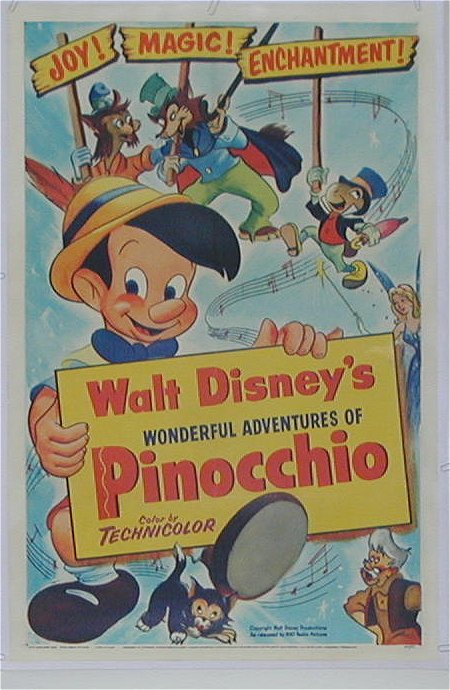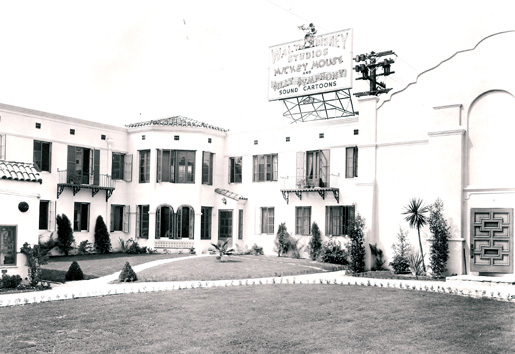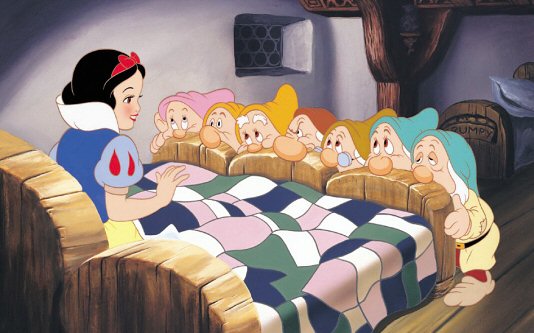
Fantasia, Disney's third animated feature,came out in 1940 and brought a very different experience than their previous efforts. Fantasia is a series of shorts put to classical music. Each is very different than the other in content and style. A famous music critic of the time, Deems Taylor, pops up between animated segments to give context and explanation. Fantasia originated with the famous short, "The Sorcerer's Apprentice." This was meant to be Mickey's grand return to prominence, but when its budget exceeded anything the studio could hope to make back, Disney, along with composer Leopold Stokowski, who was scoring the short, decided to make a series of shorts set to classical music. Each short was created to stand side by side with "The Sorcerer's Apprentice" in quality and content. Though not an immediate success, Fantasia is remembered just well as Snow White and the Seven Dwarfs and Pinocchio in importance and quality. The film was initially released as a major event, like traditional live theater. This was an occasion people dressed up for. There were only two daily screenings. Tickets cost more than regular film releases. This type of release made it hard for the movie to turn a profit early on. It also did not help that critics and viewers were not sold on the idea of Fantasia, so Disney's dream of continuing to run different shorts in theaters in this format was never fully realized. The shorts that do exist are interesting and impressive works that have withstood the years and work as a whole to provide one of the most original experiences of any Disney film.
Toccata and Fugue in D Minor: The first segment starts right up after a brief introduction by Taylor. For a while the live orchestra plays the music and the scene gradually fades to an abstract animated short. Oskar Fischinger, an abstract animator is described as a heavy influence for this short which features shapes and movement related to the music playing. This short was the first of its kind for Disney and quickly signaled to viewers the wildly different experience they were in for. While not my favorite of the shorts, this works well as an introduction to the bold concept of Fantasia, and the combination of the Disney style with such an abstract look is interesting to watch.

Nutcracker Suite: The second segment uses one of the most instantly recognizable songs in the film, though apparently The Nutcracker was rarely performed in 1940. The animation is significantly more literal this time around, but the content is unexpected for such a traditional classical song. As the seasons change from Summer to Fall, and Fall to Spring, nature seems to dance to this famous song. Fairies (which might not pass in modern Disney animation), fish (similar to Cleo in Pinocchio), flowers, leaves and the memorable mushrooms make this one of the more entertaining and beautiful segments. It is interesting to see how directly this film references skills learned in other Disney animation, and seems similar in style to future works such as Bambi.
The Sorcerer's Apprentice: Here it is, the most famous of the segments from this film, and one of the most famous Mickey Mouse shorts ever. Disney, took out all the stops to make this one and it shows in every frame. The animation is wonderfully fluid. There is so much happening onscreen. The countless brooms dumping water, the lighting effects, every element comes together making it easy to understand this shorts enduring popularity. This is one of the longest Mickey shorts ever, and one of my earliest Disney memories. I am not sure if I ever watched Fantasia in it's entirety as a child, but I know I had a VHS that included this short amongst other Disney work. For sentimental reasons this is easily one of my favorites of the lot. There is also an interesting technical moment between the animated Mickey and the real life Stokowski as they shake hands in silhouette at the end.

The Rite of Spring: This short tells the story of the origin of the earth to the extinction of the dinosaurs set to Stravinsky's classic, continuing the film's inventive subject matter for the classical music. The animation in this short is some of the most impressive work done in the whole film. The dinosaurs look intimidating and monstrous. They feel as if they have real mass and depth. The effects including lava are also eye popping. The music was rearranged and Stravinsky was apparently not to fond of the final product, even though he was supportive during the creation. Out of all of the shorts, this is probably my current favorite. I could watch cartoon dinosaurs stomp around weekly. The colors and shadows are so expressive. I imagine the non Disney feature, Land Before Time, looked back at this short for inspiration. This segment led to the intermission for the original release.
Meet the Soundtrack: This brief segment visualizes sound in the form of a line making various movements and forming various shapes. Fantasia was the first film released in stereophonic sound, a much advertised bonus to the theatrical experience so sound was a vital aspect of the experience.

The Pastoral Symphony: This short, set to Beethoven's Sixth Symphony, takes place in a mythical ancient Greece. It features unicorns, centaurs (another thing that wouldn't fly in modern Disney animation), and many other mythological creatures. There is a lot of fun color going on that set the lighter mood. While still an interesting choice of story to accompany the music, this is one of the most literal translations as most of it takes place in an actual pastoral setting, mythical creatures or not. This short is also one of the most recognizably Disney in style, featuring cute animals and a romantic story, even though it was also one of the most criticized for some of its original content, including sexy centaurs and some racial content that has since been edited out.
Dance of the Hours: This segment is one of most fun parts of the film. Animals dancing to the music is a simple concept, but it works great. The ostriches, hippos, elephants, and alligators are all well done and a amusing to watch. This short works with the music because it does not take itself too seriously, but it is also not overly goofy. This is another one that represents what the classic Disney look. The dancing and motion throughout is very complex and was probably quite a chore to animate to the music. The color of the background as the day passes add a great bit of mood and style. It is nice to see such a goofy short in the middle of a lot more experimental and serious subject matter.

Night on Bald Mountain and Ave Maria: The finale to the extravaganza is appropriately elaborate. This is the longest short of the set, and incorporates a variety of styles and effects that Disney had mastered. This episode takes place over the course of two classical pieces divided when good overcomes evil. Chernabog, the evil creature in this segment, is one of the most memorable Disney characters of all time. His design and motion are beautiful to watch. His large size overwhelms everything else present in the first part of this feature. The last half switches tone as evil is put in its place. This portion is a lot more mellow compared to the chaos and motion of the first half. It winds down nicely and works as a fitting conclusion to the entire film.
In between each segment, Taylor explains the upcoming piece and other minor musical interludes take place. It comes across like Disney was afraid the audience would not understand the feature, and preemptively went about explaining it. When the film was later distributed in more traditional channels it was heavily edited. These segments were entirely removed and many pieces were cut down to get the picture to a more reasonable run time.

Fantasia eventually found great success. It was released as a "psychedelic experience" in the 60s and has had many other popular re-releases since then. Critics have also come around to the film; it is now considered one of the best Disney features of all time. I remember thinking this was one of the worst cartoons ever when I was child, even though I am not sure whether I actually watched it or not. I am glad I have grown up enough to reevaluate that opinion, as Fantasia has become one of my favorites Disney films ever. I do not watch it as much as some of the modern classics, and it definitely requires a certain mood to enjoy, but the overall consistency from short to short and the wide variety of style and technique are definitely something to behold. It is like there was just too much imagination at Disney in the late 30s. It could not be contained in a standard animated feature. If you have never seen Fantasia before, you should definitely check it out. Whether as a "psychedelic experience" or straight, it is a beautiful piece of animation and a touchstone in the argument that animation should be considered a fine art.
If you want to read more about The Disney Challenge, click here










